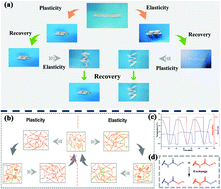Intrinsic toughened conductive thermosetting epoxy resins: utilizing dynamic bond and electrical conductivity to access electric and thermal dual-driven shape memory†
Abstract
Epoxy resins are currently the most widely used thermosetting polymers due to their high thermal stability, excellent electrical insulation, and chemical resistance. However, the application of epoxy resins are greatly limited by their inherent defects of poor toughness, difficult recyclability, and lacking shape plasticity due to forming a three-dimensional network structure. In this work, a uniquely intrinsic toughened thermosetting epoxy resin, namely EPU, was synthesized via integrating a conductive black (CB) and polyurethane system into the traditional thermosetting epoxy resins. This work cleverly introduces polyurethane system into the molecular chain of an epoxy resin, not only improving its intrinsic toughness from the molecular structure level, but also endowing the epoxy resin with dynamic performance because of the reversible exchange reaction between carbamate bonds at high temperature. The devised EPU demonstrated tunable and remarkable mechanical properties by utilizing different ratios of polyurethane in the system, with the maximum value of ultimate tensile strength and elongation at break reaching 20.7 MPa and 430.1%. In particular, with the help of the dynamic performance, the synthetic conductive thermosetting epoxy resin (named here as EPU1-CBs) could realize the thermotropic shape memory function, displaying intriguing thermal- and electric-induced shape plasticity. In this dual-driven process, the voltage could be applied at any two places of the EPU1-CBs to achieve precise local heating, achieving a faster electric-induced shape memory. Design this style of EPUs and EPU1-CBs has great significance for overcoming the poor toughness of traditional thermosetting epoxy resins and their difficult shape plasticity after curing to form a crosslinked network. Importantly, it provides a new route for devising intrinsic toughened conductive thermosetting epoxy resins through molecular structure, greatly expanding the application field of epoxy resin.



 Please wait while we load your content...
Please wait while we load your content...